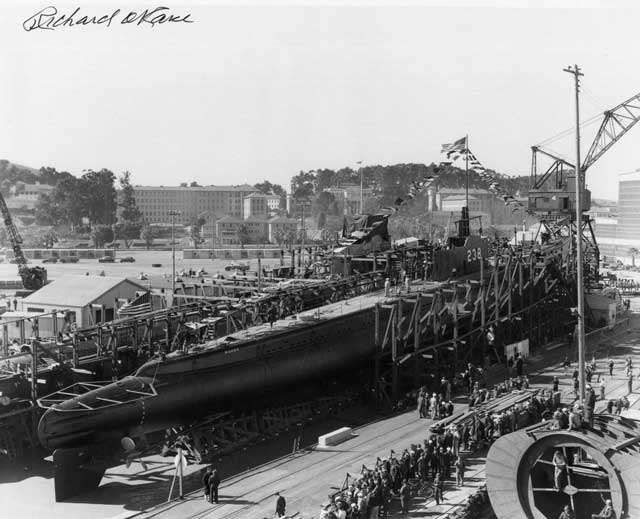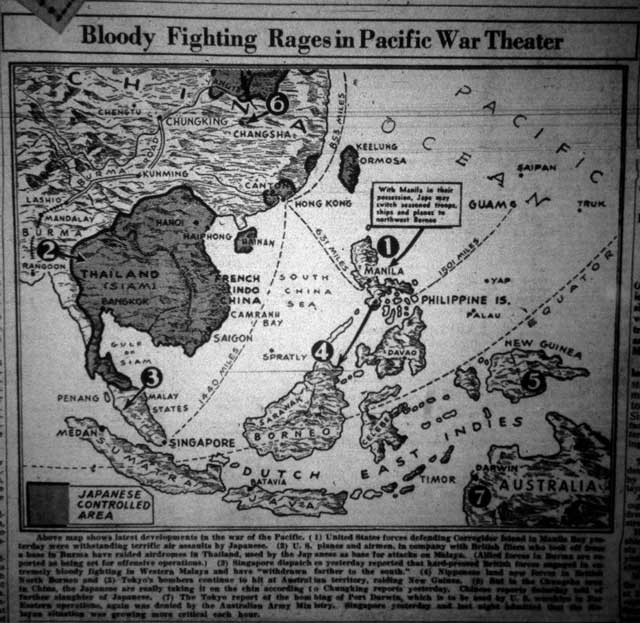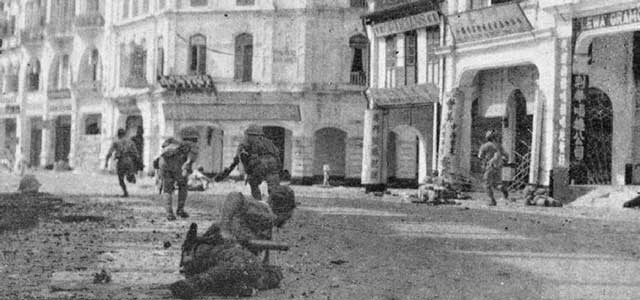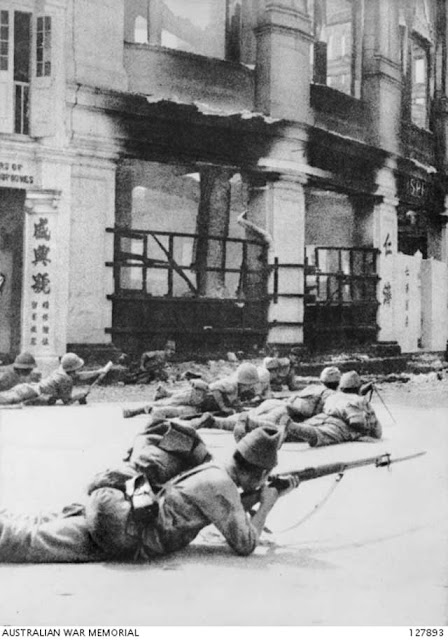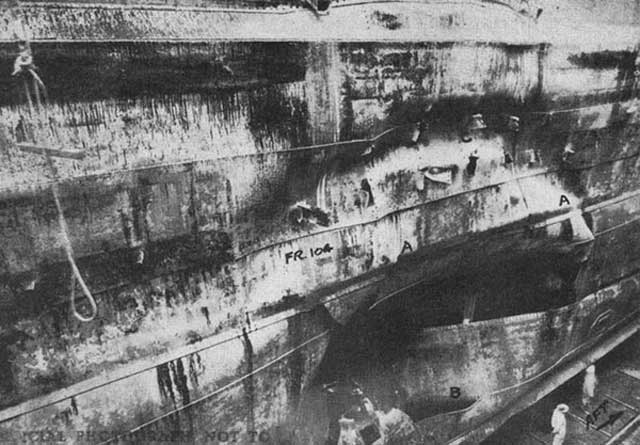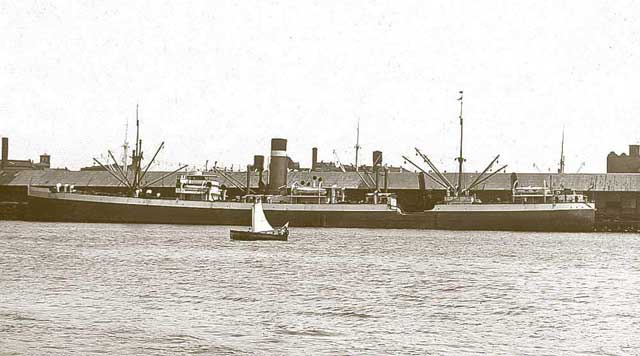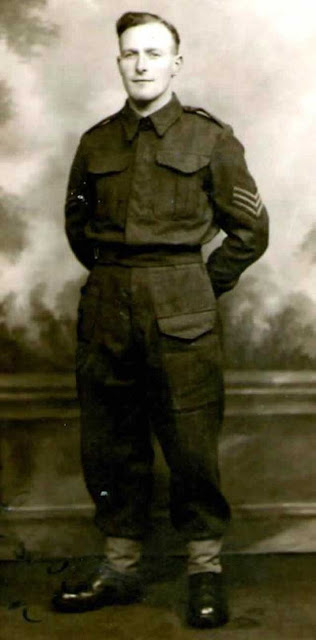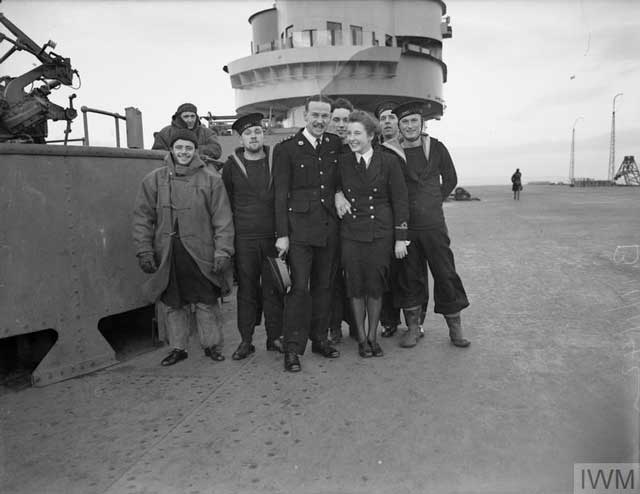Saturday 14 February 1942
To focus attacks on the morale of the enemy civil population and in particular the industrial workers. In the case of Berlin harassing attacks to maintain fear of raids and to impose A. R. P. measures."
By adopting this directive, the RAF essentially ratifies the strategy adopted by the Luftwaffe in September 1940 during the Battle of Britain. From now on, the goal of RAF bombing missions is to use its maximum power ("You are accordingly authorized to employ your forces without restriction") against the "built-up" parts of cities (as clarified by instructions issued on 15 February). The Area Bombing Directive marks a radical and controversial reorientation of the Allied bombing campaign which leads to the incineration of civilian areas of cities on the Continent. While the Area Bombing Directed at times is amended and eventually superseded, its underlying strategy remains in effect through the rest of World War II. It is not customary to call this strategy "terror raids" - that is reserved for Luftwaffe attacks - but the strategy employed by the RAF is virtually indistinguishable from that followed by the Luftwaffe. The only real distinction is that the Luftwaffe did it first.
In air operations, RAF Bomber Command sends 98 bombers to attack Mannheim. The weather is very poor, and the damage is minimal. While 67 bomber crews claim to have bombed the target, most almost certainly bombed somewhere else. There are no deaths in Mannheim, only one man wounded, and two buildings destroyed. The RAF loses a Hampden and a Whitley bomber. In a secondary mission, 15 bombers attack Le Havre without loss.
The Allied ABDA Command (General Wavell) orders the ABDA task force to intervene in the waters off Palembang. Under the command of Dutch Rear Admiral Karel Doorman, RNN, the force sets out with heavy cruiser HMS Exeter, light cruisers HMAS Hobart, HNMS De Ruyter, HNMS Java, HNMS Tromp, and ten destroyers. The operation gets off to a bad start when destroyer HNMS Van Ghent runs aground on a reef north of Banka Island and has to be scuttled.
 |
| [Argus Supplement, 14 February 1942.] |
 |
| The Vyner Brooke, sunk by the Japanese with great loss of life on 14 February 1942. |
The inhabitants of Singapore know that time is short, and many desperate people attempt to flee in overloaded small vessels. Basically, anything that can float is loaded up with refugees and sent into the night. However, the Japanese actively interdict these sailings with extreme prejudice. Japanese bombers sink 1670-ton SS Vyner Brooke off Banka Island, with only 65 of 300 aboard surviving. Many of those who perish are nurses and wounded servicemen. The 625-ton British river gunboat HMS Dragonfly (T11) is bombed and sunk off Singapore with 32 known crew deaths and an unknown number of passenger deaths. The Japanese take two crewmen as prisoners. There are many other small boats sunk in the area as well full of desperate people, such as converted whaler HMS Trang being used as a patrol boat and tug HMS St. Breock.
 |
| HMS Dragonfly, sunk by Japanese aircraft near Singapore on 14 February 1942. |
The British are quickly coming to grip with the deteriorating situation in Singapore. General Archibald Wavell, Commander in Chief ABDA Command, orders Lieutenant-General Arthur Percival, General Officer Commanding Malaya Command, to fight on. However, for the first time, Wavell qualifies this a bit, writing that it is:
wrong to enforce needless slaughter... I give you discretion to cease resistance...Whatever happens, I thank you for gallant efforts of the last few days.
Regardless of what Percival wants to do, his hands are effectively tied by the fact that the Japanese have captured the city's reservoirs. Brigadier Ivan Simson reports that the city only has enough water left for 48 hours. Percival bravely responds, "While there's water, we fight on."
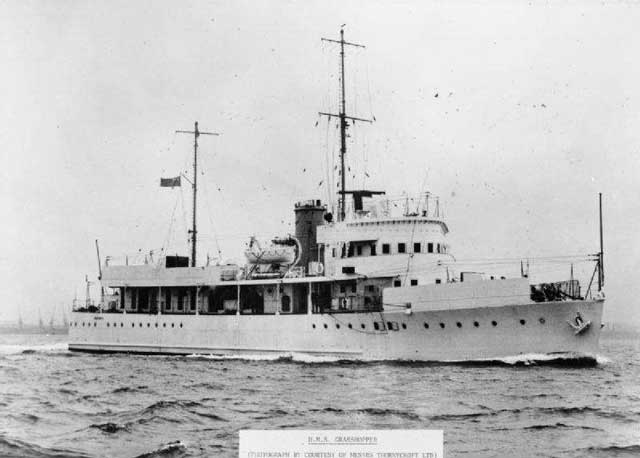 |
| HMS Grasshopper, sister ship of HMS Dragonfly, is also sunk on 14 February 1942. She is sunk south of Singapore by Japanese forces on 14 February 1942. |
In Burma, the Battle of Bilin River begins when the Japanese 55th Division attacks the main British line along the Bilin River. The defending 17th Infantry Division of the British Indian Army holds out in a vicious hand-to-hand battle, but the Japanese just keep them occupied while they send troops through the jungle to cut off the Allied troops.
Japanese submarine HIJMS I-23 disappears south of Oahu, Hawaii, without a trace around this date. I-66 torpedoes and sinks 2076-ton British freighter Kamuning in the Indian Ocean, with three crewmen perishing.
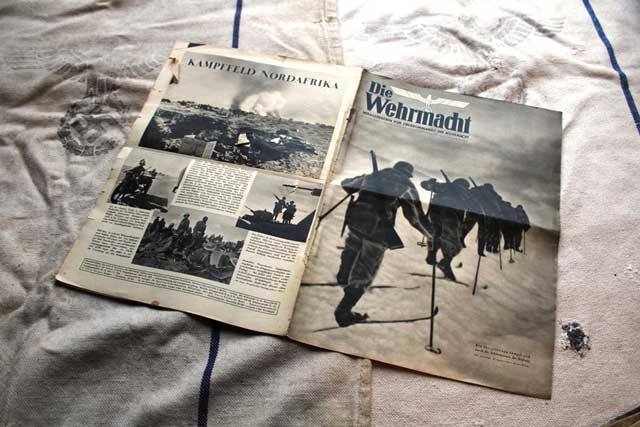 |
| Die Wehrmacht military magazine, 14 February 1942. |
Battle of the Atlantic: U-576 (Kptlt. Hans-Dieter Heinicke), on its third patrol out of St. Nazaire, torpedoes 6946-ton British freighter Empire Spring south of Newfoundland and 50 miles southeast of Sable Island at 03:37. The ship takes 15 minutes to sink, so Captain Heinicke pumps another torpedo into it to hurry things along at 03:53. This does the trick, with the ship breaking in two and sinking quickly. There are 55 dead and no survivors.
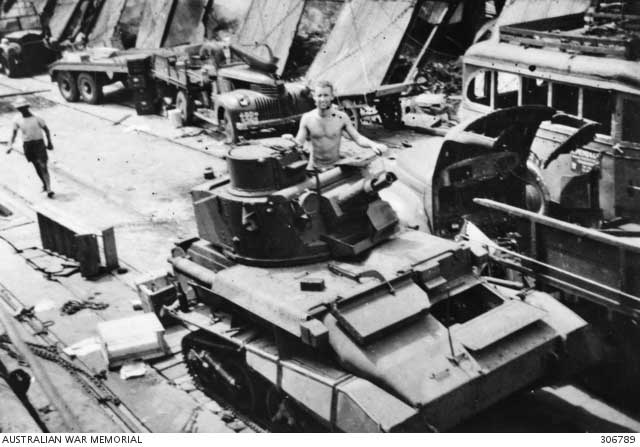 |
| "Oosthaven, Sumatra, Netherlands East Indies. 1942-02. A light tank MkV1B from a Light Tank Squadron of the 3rd Hussars, British Army, on the wharf. The unit had disembarked on 1942-02-14 at the port which faced the Sunda Strait on the southern tip of Sumatra. They were part of the force which was given the task of defending the area and covering the evacuation of the troops and civilians on 1942-02-17. (Navy Historical Collection) (Formerly Y047)." Australian War Memorial 306789. |
Panzer Army Africa commander Lt. General Erwin Rommel sends a proposal to the OKH (German Army high command) for a complete reorganization of his forces. Rommel asks to include a three-battalion Schutzen Regiment in every Panzer division and the creation of a second motorized infantry division. OKH eventually approves these changes and related changes but rejects some other proposals. The two Panzer Army Panzer divisions, the 15th and 21st Panzer divisions, each wind up with a two-battalion Panzer regiment and three-battalion Schutzen Regiment. The new groupings take effect on 1 April 1942 and become the classic form of the Afrika Korps remembered by history. A more immediate change takes place now when a fourth Beute (booty) Batterie composed of captured British 25-pdr guns is added to each division.
War Crimes: Japanese troops capture the Alexandria Hospital on the outskirts of Singapore City and execute many staff and patients with their bayonets. They then imprison 150 survivors into a nearby bungalow and execute them on 15 February. This war crime is very similar to atrocities the Japanese committed in Hong Kong during its capture.
 |
| Major Frank Capra at his desk in the War Department (AP). |
Famed Hollywood director Frank Capra, who enlisted within four days of Pearl Harbor despite being 44 years of age, takes over as wartime propaganda director for the Army Signal Corps of the War Department. Capra, with the rank of Major, eventually heads the 834th Signal Service Photographic Detachment, which produces orientation films. His most renowned documentary series during this period, "Why We Fight," becomes the most widely seen and influential of all wartime documentaries.
The 9th Pursuit Squadron, 49th Pursuit Group (Interceptor) of 5th Air Force relocates from Melbourne to Williamstown, Australia. At Fiji, the 22nd Bombardment Squadron (Heavy) begins operating its B-17s from Nandi Airport under the control of the United States Navy.
Today is the first flight of the Douglas C-54 Skymaster, the military version of the DC-4. The C-54 flies from Clover Field in Santa Monica, California.
Today is the first flight of the Douglas C-54 Skymaster, the military version of the DC-4. The C-54 flies from Clover Field in Santa Monica, California.
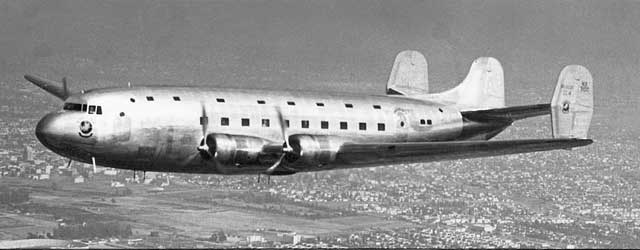 |
| Inflight view of prototype Douglas DC-4E in 1938. The military version, C-54, first flies on 14 February 1942. |
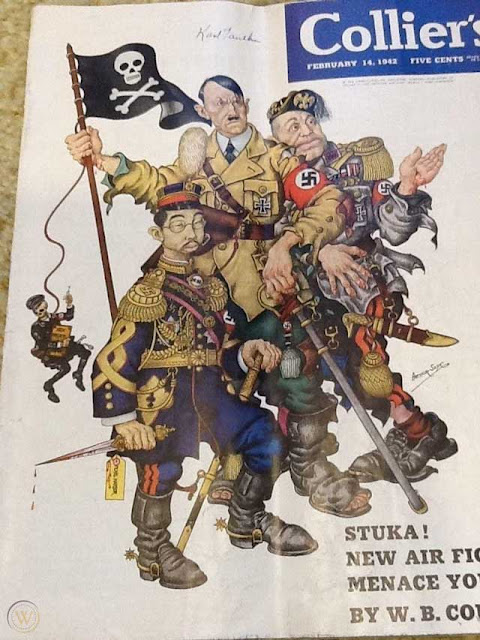 |
| Collier's, 14 February 1942 (cover art by Arthur Szyk). |
Radio series "This is War!" debuts on all four radio networks: the Blue Network (much later, ABC), CBS, Mutual, and NBC. Top Hollywood stars appear on the 30-minute broadcasts to support the war effort. "This is War!" continues for a 13-week run.
The War Plans Division prepares a formal recommendation that the Hawaiian commander:
be authorized to evacuate all enemy aliens and all citizens of Japanese extraction selected by him with their families, subject to the availability of shipping and facilities for their internment or surveillance on the mainland.
This is just a recommendation at this point and is being circulated within the Army for comment. Secretary of the Navy Frank Knox asks President Roosevelt for his opinion, and the President responds:
Like you, I have long felt that most of the Japanese should be removed from Oahu to one of the other Islands. This involves much planning, much temporary construction and careful supervision of them when they get to the new location. I do not worry about the constitutional question-first, because of my recent order [Executive Order 9066] and, second, because Hawaii is under martial law. The whole matter is one of immediate and present war emergency. I think you and Stimson can agree and then go ahead and do it as a military project.
Ultimately, however, the War Plans Division concludes that it is impracticable to imprison the Japanese on another Hawaiian Island.
Future History: Michael Rubens Bloomberg is born in Brighton, Massachusetts. After matriculating at Johns Hopkins University and the Harvard Business School, Bloomberg eventually becomes a general partner at investment firm Salomon Brothers and then, after many business twists and turns, the founder of Innovative Market Systems. His Bloomberg terminals become necessary equipment throughout the financial industry around the world. Eventually, Bloomberg enters politics and serves two terms as the 108th Mayor of New York City. Michael Bloomberg remains active in business and politics as of this writing in 2019 as a Presidential candidate.
 |
| The New Yorker, 14 February 1942 (painting by Julian De Miskey). |
February 1942
February 1, 1942: The US Navy Strikes Back
February 2, 1942: Germans Recovering in Russia
February 3, 1942: Japanese Shell and Bomb Singapore
February 4, 1942: Battle of Makassar Strait
February 5, 1942: Empress of Asia Sunk
February 6, 1942: The Christmas Island Body
February 7, 1942: The Double-V Campaign
February 8, 1942: Japan Invades Singapore
February 9, 1942: French Liner Normandie Capsizes
February 10, 1942: US Car Production Ends
February 11, 1942: Tomforce Fails on Singapore
February 12, 1942: The Channel Dash
February 13, 1942: Japanese Paratroopers In Action
February 14, 1942: RAF Orders Terror Raids
February 15, 1942: Japan Takes Singapore
February 17, 1942: Indian Troops Defect to Japanese
February 18, 1942: Battle of Badung Strait
February 19, 1942: FDR Authorizes Internment Camps
February 20, 1942: O'Hare the Hero
February 21, 1942: Crisis in Burma
February 22, 1942: Bomber Harris Takes Over
February 23, 1942: Bombardment of Ellwood, California
February 24, 1942: US Raid on Wake Island
February 25, 1942: Battle of Los Angeles
February 26, 1942: Gneisenau Eliminated
February 27, 1942: Battle of Java Sea
February 28, 1942: Battle of Sunda Strait
2020
